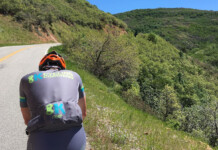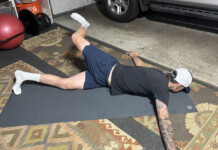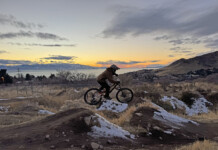By John Higgins
Cycling is supposed to be fun and enjoyable. It can also be a butt-kicking workout. Either way, persistent discomfort or pain should not be a regular part of the experience. If you suffer from riding-related pain in your feet, knees, hips, lower back, shoulders and neck, wrists or hands, or just wear yourself out faster than seems reasonable, something is not right with your bike – body relationship.
All bikes have elements of “passive comfort” which may be changed to enhance your riding enjoyment. Passive comfort is influenced by the following factors:
• Frame Shape and Size
• Seat and handlebar position
• Tire Selection and Pressure
• Seat and Seat Post
• Handlebars
• Clothing (Gloves, Shorts, Shoes)
In addition, mountain bikes and some hybrid bikes have suspension (front only or full) to adjust. Suspension provides “active comfort” to a bicycle.
Some of these factors you can experiment with yourself, and some may require the assistance of a bike fitter to provide an objective assessment.
Frame Shape and Size
A bike’s frame geometry or shape determines to a large extent your body position on the bike. Does your bike encourage you to sit upright for comfort or adopt a strong aerodynamic position for performance? If the frame geometry does not match your intended riding style, strength and flexibility, there is little that can be done to alleviate discomfort short of getting a different bike, although a bike fit (see below) may assist.
The correct frame size is also an important factor for rider comfort. It is rare to be sold the wrong frame size when buying a new bike. But it is common for the buyer of a used bike, or the beneficiary of a hand-me-down, to be on a frame too big or small, and experience physical discomfort as a result. Seek a second opinion to confirm your frame size, and take a short test ride if possible to get your body’s feedback on the riding position. An online or in store purchase of the wrong frame size can sometimes be exchanged for the right size.
Seat and Handlebar Position
The position of the seat in relation to the pedals, and the handlebars in relation to the seat are important variables. These relationships are determined by established biomechanical principles, and the rider’s strength, muscle balance, flexibility and riding style. Many cyclists experiment with these, but it’s challenging to optimize your position on your own. If something just doesn’t feel right, and you cannot figure it out, get a bike fitter to assess and correct your positioning.
Tire Selection and Pressure
The type of tire and the pressure at which it is run can have a noticeable effect on both riding comfort and traction. A wide tire provides more cushion and comfort than a narrow tire, since the weight of both bike and rider are supported on a bigger air cushion over a larger surface area. The disadvantage (for some) is more weight and an increase in effort that is needed to accelerate and maintain momentum.
A common misconception for road or urban bikes is to pump up the tires to the manufacturer’s recommended maximum pressure (found on the tire sidewall) in order to reduce rolling resistance. Maximum pressure is not the same as ideal pressure. Overinflated tires have less ability to absorb road surface imperfections, transmitting more vibration to the rider. Experiment with your tire pressure to find a balance between a too soft and sluggish ride quality versus a too hard and harsh ride quality. Pinch flats are a sign that the pressure is too low. A harsh ride quality is a sign that the pressure it too high.
For mountain bikers, the trend has been toward wider tires run at lower pressures. This improves the tires’ grip on the trail surface, giving better control and providing more passive suspension. It also reduces rider fatigue on rough trails or long rides.
The biggest factor affecting recommended tire pressure is the rider’s weight, followed by riding surface and conditions, and tire size and volume. Use lower pressures for lighter riders, rougher and wetter conditions, and with higher and wider tire profiles. Use higher relative pressures for heavier riders, smoother and dryer conditions, and smaller and narrower tire profiles.
Some tire manufacturers post a rider weight / tire pressure chart on their web site.
Seat and Seat Post
If you are new to cycling or have returned after a long absence, it is normal to have some posterior soreness while your body adjusts to the new pressure and exertion. However, if you experience any sharp or persistent pains, strong discomfort or numbness, then try out a different seat. First though, make sure your seat is level, and not angled up or down. Most major seat brands offer a satisfaction guarantee return policy as it can take some experimentation to find the right seat.
Bike seats and posteriors both vary in size and shape, and you want a happy match. Seat designs differ for men and women and for different types of bikes.
Seat shape is more important than padding:
• A broad seat is best for an upright riding position in which most of the rider’s weight is directed down through the sit bones.
• A narrow seat is more suitable for a forward leaning position in which your pelvis is rotated forward, and weight is transferred to the handlebars.
If you have an upright riding position, and your back gets jarred from the impact of bumps, you may benefit from a suspension seat post. The seat post connects the seat to the bike frame. Most are a rigid tube of alloy or carbon fiber. A seat post with built-in suspension softens bumps through an incorporated spring or elastomer. These are common on some new hybrid bikes, or can be ordered as an aftermarket item through your local bike shop.
Handlebars
Handlebars come in many shapes and sizes. The most common styles are drop bars, as found on most road and touring bikes, and flat bars, as found on mountain bikes, many hybrid / urban bikes and a few road bikes.
Discomfort issues related to handlebars include:
1. Hand numbness: This is often caused by nerve compression, or by having too much weight on the hands. Nerve compression can often be addressed on a flat bar bike by changing the original round bar grips to an ergonomic bar grip. If the height to the handlebar grips is significantly lower than the height to the top of the seat, it may indicate too much weight is being transferred to your hands, and a higher bar position would be more comfortable. This may be achieved by a change in bar stem, or the bar itself. The angle of the seat can affect this as well.
2. Wrist pain: This can result from too much body weight being supported by the hands, or from the angle of the handlebars or position of the hoods on a drop bar. It’s best diagnosed and remedied through a professional bike fitting session.
3. Control lever reach: If it’s awkward to reach a gear shifter or brake lever, adjustments to the lever position and reach can often be made to bring the controls within a more comfortable reach. Experiment with these or seek a professional bike fit.
On drop bars, the handlebar tape can influence comfort. High-quality tape is usually thicker and better at absorbing road vibration than an inexpensive tape. If tingling or numbness persists when using a drop bar, this may be reduced by having the bars wrapped with an underlay of gel tape, before the bar tape goes on.
Clothing (Gloves, Shorts, Shoes)
Two clothing items can add to your comfort: gloves and padded cycling shorts.
Cycling gloves are often overlooked by casual riders, but they serve 4 useful purposes:
• Vibration absorption
• Better grip on the handlebars
• Protection from sunburn in summer and cold fingers in winter
• Hand protection from abrasion in the event of a spill
Get the right size. Gloves should fit comfortably when gripped onto a bar, being neither too tight and constricting across the back of the hand nor too loose and bunched up under the palm.
Fingerless, padded gloves are popular for summer pavement riders. As mountain bikers already have at least front suspension, the palm padding is often reduced and the fingers fully covered for increased protection from trailside vegetation or wipe outs.
Cycling shorts contain a padded synthetic chamois pad in the crotch. Worn next to the skin, cycling shorts protect the rider from saddle chafing, wick away moisture and provide a bump-absorbing padding. Applying a chamois cream further reduces any risk of chafing, especially if your rides are multi-hour or over consecutive days.
Shoes can add or subtract from your riding experience. If you are using flat pedals, a recreational cycling shoe will offer a stiffer, supportive sole than a regular athletic shoe, but with enough flex for easy walking. A shoe designed for running is too soft for any cycling that is longer than a casual jaunt. If you are using cleats and cycle shoes, then the most common problem is a shoe that is too narrow in the forefoot, contributing to nerve compression and subsequent pain. Anyone who has experienced “hot foot” knows exactly why it is called this, but not why it occurs. There can be a number of causal factors, including cleat placement and arch support, but shoe fit is the top culprit.
By adjusting your bicycle to suit you, instead of trying to adapt your body to suit your bike, riding stress and discomfort can be reduced. Keep in mind that as your age and fitness change, so does your optimal riding position. You can experiment yourself or seek the service of an experienced bike fitter. A comprehensive bike fitting is one of the best “upgrades” you can purchase. A bike fit first determines that you have the appropriate frame size, then assesses and adjusts your bike-body relationship for comfort, efficiency and power.
John Higgins is a cycling enthusiast, competitor and bike fitter. Contact him at www.bikefitr.com








